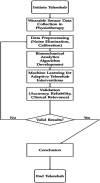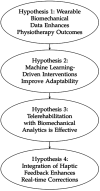Advanced biomechanical analytics: Wearable technologies for precision health monitoring in sports performance
- PMID: 38840658
- PMCID: PMC11151756
- DOI: 10.1177/20552076241256745
Advanced biomechanical analytics: Wearable technologies for precision health monitoring in sports performance
Abstract
Objective: This study investigated the impact of wearable technologies, particularly advanced biomechanical analytics and machine learning, on sports performance monitoring and intervention strategies within the realm of physiotherapy. The primary aims were to evaluate key performance metrics, individual athlete variations and the efficacy of machine learning-driven adaptive interventions.
Methods: The research employed an observational cross-sectional design, focusing on the collection and analysis of real-world biomechanical data from athletes engaged in sports physiotherapy. A representative sample of athletes from Bahawalpur participated, utilizing Dring Stadium as the primary data collection venue. Wearable devices, including inertial sensors (MPU6050, MPU9250), electromyography (EMG) sensors (MyoWare Muscle Sensor), pressure sensors (FlexiForce sensor) and haptic feedback sensors, were strategically chosen for their ability to capture diverse biomechanical parameters.
Results: Key performance metrics, such as heart rate (mean: 76.5 bpm, SD: 3.2, min: 72, max: 80), joint angles (mean: 112.3 degrees, SD: 6.8, min: 105, max: 120), muscle activation (mean: 43.2%, SD: 4.5, min: 38, max: 48) and stress and strain features (mean: [112.3 ], SD: [6.5 ]), were analyzed and presented in summary tables. Individual athlete analyses highlighted variations in performance metrics, emphasizing the need for personalized monitoring and intervention strategies. The impact of wearable technologies on athletic performance was quantified through a comparison of metrics recorded with and without sensors. Results consistently demonstrated improvements in monitored parameters, affirming the significance of wearable technologies.
Conclusions: The study suggests that wearable technologies, when combined with advanced biomechanical analytics and machine learning, can enhance athletic performance in sports physiotherapy. Real-time monitoring allows for precise intervention adjustments, demonstrating the potential of machine learning-driven adaptive interventions.
Keywords: Biomechanics; athlete optimization; precision health monitoring; sports performance; wearable technologies.
© The Author(s) 2024.
Conflict of interest statement
The authors declared no potential conflicts of interest with respect to the research, authorship, and/or publication of this article.
Figures








Similar articles
-
Research Progress on Applying Intelligent Sensors in Sports Science.Sensors (Basel). 2024 Nov 17;24(22):7338. doi: 10.3390/s24227338. Sensors (Basel). 2024. PMID: 39599115 Free PMC article. Review.
-
Wearable Technology and Analytics as a Complementary Toolkit to Optimize Workload and to Reduce Injury Burden.Front Sports Act Living. 2021 Jan 21;2:630576. doi: 10.3389/fspor.2020.630576. eCollection 2020. Front Sports Act Living. 2021. PMID: 33554111 Free PMC article. Review.
-
A Wearable-Sensor System with AI Technology for Real-Time Biomechanical Feedback Training in Hammer Throw.Sensors (Basel). 2022 Dec 30;23(1):425. doi: 10.3390/s23010425. Sensors (Basel). 2022. PMID: 36617025 Free PMC article.
-
The Fundamentals and Applications of Wearable Sensor Devices in Sports Medicine: A Scoping Review.Arthroscopy. 2025 Feb;41(2):473-492. doi: 10.1016/j.arthro.2024.01.042. Epub 2024 Feb 7. Arthroscopy. 2025. PMID: 38331364
-
Wearable Sensors and Smart Devices to Monitor Rehabilitation Parameters and Sports Performance: An Overview.Sensors (Basel). 2023 Feb 7;23(4):1856. doi: 10.3390/s23041856. Sensors (Basel). 2023. PMID: 36850453 Free PMC article. Review.
Cited by
-
Artificial Intelligence for Objective Assessment of Acrobatic Movements: Applying Machine Learning for Identifying Tumbling Elements in Cheer Sports.Sensors (Basel). 2025 Apr 3;25(7):2260. doi: 10.3390/s25072260. Sensors (Basel). 2025. PMID: 40218772 Free PMC article.
-
Special Issue "Biomechanical Analysis in Physical Activity and Sports".J Funct Morphol Kinesiol. 2025 Mar 30;10(2):116. doi: 10.3390/jfmk10020116. J Funct Morphol Kinesiol. 2025. PMID: 40566413 Free PMC article.
-
Neurosciences and Sports Rehabilitation in ACLR: A Narrative Review on Winning Alliance Strategies and Connecting the Dots.J Funct Morphol Kinesiol. 2025 Apr 2;10(2):119. doi: 10.3390/jfmk10020119. J Funct Morphol Kinesiol. 2025. PMID: 40566416 Free PMC article. Review.
-
Research Progress on Applying Intelligent Sensors in Sports Science.Sensors (Basel). 2024 Nov 17;24(22):7338. doi: 10.3390/s24227338. Sensors (Basel). 2024. PMID: 39599115 Free PMC article. Review.
-
Challenges in Combining EMG, Joint Moments, and GRF from Marker-Less Video-Based Motion Capture Systems.Bioengineering (Basel). 2025 Apr 27;12(5):461. doi: 10.3390/bioengineering12050461. Bioengineering (Basel). 2025. PMID: 40428080 Free PMC article. Review.
References
-
- Binyamin SS, Hoque MR. Understanding the drivers of wearable health monitoring technology: an extension of the unified theory of acceptance and use of technology. Sustainability 9605; 12: 2020.
-
- Chen F. Athlete muscle measurement and exercise data monitoring based on embedded system and wearable devices. Microprocess Microsyst 2021; 82: 103901.
LinkOut - more resources
Full Text Sources

